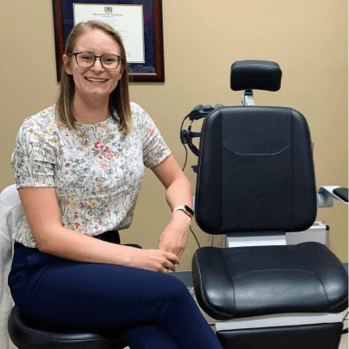Your eyes are unique, and in the case of astigmatism, they can require individualized solutions. Your optometrist can help you find the right contact lenses for your unique visual needs. The first step to achieving clear, comfortable, frame-free vision is a comprehensive contact lens exam and fitting to determine your precise needs.
Astigmatism is a common vision condition that causes blurred vision. Toric contact lenses are an excellent option to help manage the effects of astigmatism and help you see clearly.
Let’s explore toric lenses and other options that are the best for people who have astigmatism.
What Is Astigmatism?
Astigmatism occurs when the cornea (the clear front surface of the eye) or the lens inside the eye is irregularly shaped. What this means is that instead of your eye having a round ball-like curve, the eye’s surface may be egg-shaped, causing blurred vision at varying distances.
Some common signs and symptoms for people with large amounts of astigmatism can include:
- Blurry vision at varying distances
- Eye strain
- Trouble seeing at night
- Needing to squint to see clearly
If you have mild astigmatism, you may not notice many symptoms. Regular eye exams with your eye doctor can track changes in your vision, like the development of astigmatism.
Astigmatism can develop at any age and may be influenced by several risk factors, including:
- Genetics
- Eye injuries
- Eye disease
- Previous eye surgeries
- Eye rubbing
Astigmatism can develop alongside other vision conditions like myopia (nearsightedness) and hyperopia (farsightedness).
How Your Eye Doctor Can Help
Your eye doctor can help diagnose and recommend solutions to manage your astigmatism at your comprehensive eye examination. Your eye exam includes an overview of your medical and family history and an opportunity to discuss questions or concerns you have with your optometrist,
The next step is to thoroughly test your eyes and vision using personalized testing and technology. These tests can include:
- Visual acuity
- Keratometry
- A cover test
- An ocular movement test
- A refraction test
- A slit lamp examination
Following your exam, your optometrist can determine an astigmatism solution for you through prescription eyeglasses and specialty contact lenses.

Contact Lenses for Astigmatism
Contact lenses fall under 2 main categories: soft contact lenses and rigid gas permeable (RGP) lenses. Among these categories are other specialty lenses used for various visual needs, like toric lenses for astigmatism.
What Are Toric Contact Lenses?
Toric contact lenses are specifically designed to help correct astigmatism. These lenses account for corneal irregularities caused by astigmatism.
These lenses have 2 powers in one lens, one for correcting your astigmatism and the other for nearsightedness or farsightedness.
Toric lenses come in several different forms, including:
- Soft
- Rigid gas permeable
- Extended wear
- Daily disposable
Because toric contact lenses have a spherical design resembling the side of a ball, they can require a more precise fit. Your optometrist can complete a comprehensive contact lens exam and fitting to prescribe a safe and comfortable fit.
Keratoconus & Irregular Astigmatism
Astigmatism can come in different forms. Irregular astigmatism is uncommon when compared to “regular” astigmatism, but it is seen in patients with an irregular corneal surface brought on by natural causes or surgically induced.
Keratoconus is another condition that can affect the front window of your eye and result in poor vision. Keratoconus typically develops in the late teenage years. It causes the front window of your eye to become thin and bow outwards, distorting your vision.
RGP lenses and scleral lenses are excellent options to help manage irregular astigmatism and keratoconus to help you see clearly. Surgical options such as corneal cross-linking may be an option in certain cases.
Solving Astigmatism
Astigmatism is a common vision condition that affects all ages. Innovative contact lens technology has made it possible to correct astigmatism with specialty toric lenses. The first step to correcting your astigmatism is scheduling a comprehensive contact lens exam and fitting with your optometrist.
Book an appointment with our eye care professionals at Beyond 20/20 Optometry to find the right contact lenses to correct your astigmatism.




